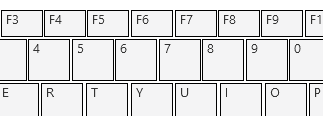比如需要显示一个键盘,里面有各个按键。实现的效果如下:

之前的思路,就是建立一个singleKey的控件,然后在后台用代码动态的添加到父控件里去, 再用代码在后台进行绑定。
这种实现方法并不是真正的MVVM的模式。体会不到MVVM带来的便捷和惊喜。
用MVVM模式来实现时的思路如下:
1. 建立singleKey的ViewModel,定义需要绑定View的属性。
2. 在Key的ViewModel中,使用可观察集合,并绑定到View的ItemsSource上。
ViewModel
public ObservableCollection<DutSingleKeyViewModel> Keysets { get { return this.keysets; } set { this.keysets = value; } }
3. 对于singleKey的显示,可以在DataTemplat里面定义。
View
<UserControl.DataContext> <vm:DutKeysetViewModel /> </UserControl.DataContext> <UserControl.Resources> <DataTemplate DataType="{x:Type vm:DutSingleKeyViewModel}"> <Canvas> <Grid Canvas.Left="{Binding KeyLocationLeft, Mode=OneWay}" Canvas.Top="{Binding KeyLocationTop, Mode=OneWay}" > <Rectangle Fill="#FFF4F4F5" HorizontalAlignment="Left" Width="{Binding KeySizeWidth}" Height="{Binding KeySizeHeight}" Stroke="Black" VerticalAlignment="Top"></Rectangle> <TextBlock HorizontalAlignment="Left" TextWrapping="Wrap" Text="{Binding KeyCharacter}" Margin="5,0,0,0" VerticalAlignment="Top" /> </Grid> </Canvas> </DataTemplate> </UserControl.Resources> <Grid> <WrapPanel HorizontalAlignment="Left" Height="227" Width="532"> <ItemsControl ItemsSource="{Binding Keysets}"> <ItemsControl.ItemsPanel> <ItemsPanelTemplate> <WrapPanel Orientation="Horizontal" /> </ItemsPanelTemplate> </ItemsControl.ItemsPanel> </ItemsControl> </WrapPanel>
于是,并不用在后台写过多的代码,修改ViewModel后, View的显示就相应变更了。
补充网上大牛的回复。
if you really want to do mvvm , try to forget "how can i add controls". you dont have to, just think about your viewmodels - WPF create the contols for you :)
in your case lets say we have a SearchViewModel and a SearchEntryViewmodel.
public class SearchEntryViewmodel
{
//Properties for Binding to Combobox and Textbox goes here
}
public class SearchViewModel
{
public ObservableCollection<SearchEntryViewmodel> MySearchItems {get;set;}
public ICommand AddSearchItem {get;}
}till now you dont have to think about usercontrols/view. in your SearchView you create an ItemsControl and bind the ItemsSource to MySearchItems.
<ItemsControl ItemsSource="{Binding MySearchItems}"/>you see now all of your SearchEntryViewmodels in the ItemsControl(just the ToString() atm).
To fit your requirements to show every SearchEntryViewmodel with 3Comboboxes and so on you just have to define a DataTemplate in your Resources
<DataTemplate DataType="{x:Type local:SearchEntryViewmodel}">
<StackPanel Orientation="Horizontal">
<Combobox ItemsSource="{Binding MyPropertyInSearchEntryViewmodel}"/>
<!-- the other controls with bindings -->
</StackPanel>
</DataTemplate>thats all :) and you never has to think about how can i add controls dynamically. you just have to add new SearchEntryViewmodel to your collection.
this approach is called Viewmodel First and i think its the easiest way to do MVVM.
在实践发现,通用的方法还是创建一个userControl view,重要的是再DataTemplate里面引用:
<Window.Resources> <DataTemplate DataType={x:Type viewmodels:MyUserControlViewModel}"> <views:MyUserControlView /> </DataTemplate> </Window.Resources>



 浙公网安备 33010602011771号
浙公网安备 33010602011771号